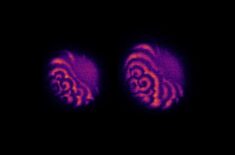What Are Chakras?
“A chakra is a center of organization that receives, assimilates, and expresses life-force energy.
The word ‘chakra’ literally translates as “wheel” or “disk” and refers to a spinning sphere of bioenergetic activity emanating from the major nerve ganglia branching forward from the spinal column.”
– Anodea Judith, Eastern Body, Western Mind
The chakra system is a seven-tiered model of an individual’s relationship to themselves, others, and the world around them.
It stems from the Yogic tradition and is used to navigate one’s ascension through different consciousness and experience levels.
Chakras are energy centers and vortices that run from the base of the spine to the crown of the head and beyond.
They can be underactive, overactive, or blocked.
A chakra’s state significantly impacts our mental/emotional state, perceptions, beliefs, choices, reactions, impulses, health, and wellness.
What Are The 7 Main Chakras?
“Each energy center is an individual center of information, with its own unique energy that carries a corresponding level of consciousness – its own emission of light – expressing very specific information.
Each center also has its own individual glands, hormones, chemistry, and plexus of neurons.
Think of these individual clusters of neurological networks as mini-brains.”
– Dr. Joe Dispenza, neuroscientist & researcher
The following is a summary of the seven main energy centers and what makes each of them unique.
We’ll start with the first chakra, the root chakra, and then ascend one by one to the top, the crown chakra.
This is how vital energy moves – in an upward direction towards ever-increasing states of awareness.
Root Chakra (first chakra)
- Yogic name: Muladhara
- Color: Red
- Location: Base of the spine, coccygeal plexus
- Themes: Survival, creative energy, reproduction, elimination
- Experience of the Self: Self-preservation
- Element: Earth
- Body Connection: Sexual organs, perineum, anus, pelvic floor, lower bowel, prostate, bladder
- Hormones: Estrogen and progesterone in women, testosterone in men
- Disorder: Fear, distrust
- Health: Grounding, stability, trust, abundance, physical health
Sacral Chakra (second chakra)
- Yogic name: Svadisthana
- Color: Orange
- Location: Behind and under the belly button, lower abdomen
- Theme: Emotions, relationships, social connections, family, culture, consuming/eliminating, hold on/let go, elimination
- Experience of the Self: Self-gratification
- Element: Water
- Body Connection: Ovaries, uterus, colon, pancreas, lower back, hips
- Hormones/Bodily Fluids: Serotonin, digestive enzymes
- Disorder: Guilt, sexuality issues
- Health: Sexual health, digestive health, emotional health, relationship health
Solar Plexus Chakra (third chakra)
- Yogic name: Manipura
- Color: Yellow
- Location: Solar plexus
- Theme: Personal power and will, control, drive, dominance, competition, intention
- Experience of the Self: Self-respect, self-importance
- Element: Fire
- Body Connection: stomach, small intestine, liver, gall bladder, adrenal glands, kidneys
- Hormones/Bodily fluids: Adrenaline, cortisol, digestive enzymes
- Disorder: Shame, aggression
- Health: Self-esteem, vitality, a sense of purpose and meaning
Heart Chakra (fourth chakra)
- Yogic name: Anahata
- Color: Green
- Location: Center of the chest, heart area
- Theme: Love, caring, connection, compassion, empathy, nurturing, gratitude, inspiration, trust
- Experience of the Self: Self-love, self-acceptance
- Element: Air
- Body Connection: Heart, lungs, thymus gland
- Hormones/Bodily fluids: Oxytocin, human growth hormone, immune system chemicals
- Disorder: Grief, sadness, apathy, disconnection
- Health: Healthy relationship to self, other, and others, care for others, love for life, living our mission/purpose
Throat Chakra (fifth chakra)
- Yogic name: Visuddha
- Color: Blue
- Location: Throat/neck area
- Theme: Communication, expression, creativity
- Experience of the Self: Self-expression
- Element: Sound
- Body Connection: thyroid and parathyroid glands, esophagus, vocal cords, salivary glands, neck tissues
- Hormone/bodily fluid: thyroid hormones T3 and T4, metabolic chemicals
- Disorder: Lies, inauthenticity, delusion
- Health: Easily speaking your truth, creating through sound, language, and colors, sharing your experience with others
Third Eye Chakra (sixth chakra)
- Yogic name: Ajna
- Color: Indigo
- Location: The space in between the brows
- Theme: Intuitive wisdom, inner vision, imagination, high dimensions of awareness, heightened perception beyond the five senses
- Self-Expression: Self-reflection
- Element: Thought
- Body Connection: Pineal gland
- Disorder: Illusion
- Health: Increased intuition and perception, sharper imagination, inner knowledge, extrasensory perception
Crown Chakra
- Yogic name: Sahasrara
- Color: White, violet, purple
- Location: Top of the head, cerebral cortex
- Theme: Awareness, spiritual connection, soul connection
- Self-Expression: Self-transcendence, Self-knowledge
- Element: Light
- Body Connection: Pituitary gland
- Hormones/bodily fluids: pituitary gland hormones
- Disorder: Attachment
- Health: Highest levels of consciousness attained, “seeing beyond the veil,” harmony, union
How Do Essential Oils Impact Chakras?
Essential oils are highly concentrated plant extracts containing hundreds of active compounds known to interact with the body and influence mental/emotional states and physical healing and well-being.
Aromatherapy is the therapeutic use and medicinal application of essential oils.
Just a few drops of essential oils on your skin can release a cascade of bodily reactions in a matter of minutes.
Think of essential oils as a plant’s essence, and each type offers a unique frequency and profile.
Different essential oils have different chakra balancing effects.
As you can see from the section above, chakras impact our mental and emotional states and different parts of the body.
You can use aromatherapy as a medium to bring more balance and harmony to your energy centers.
What Essential Oils Balance Each Chakra?
Root Chakra
Frankincense, Sandalwood, Myrrh, Pine, Balsam Fir, and Cedarwood are all grounding essences.
Use vetiver or patchouli to calm an overactive root chakra.
Use cinnamon, cardamom, or black pepper to awaken an underactive one.
The best places to apply for root chakra balancing are the soles of your feet and the lower back.
Sacral Chakra
Orange, mandarin, lemon, and bergamot are revitalizing essences that can stimulate energy flow in this center.
Ylang Ylang, neroli, jasmine, and helichrysum are floral essences that can balance sacral energies.
Apply them to your lower belly (below the belly button), or lower back.
Solar Plexus Chakra
Grapefruit, lemon, lemongrass, and ginger are all excellent choices for awakening this energy center and activating personal power.
Apply the oils to your upper belly (above the belly button) and mid-back areas.
Heart Chakra
Rosewood, geranium, marjoram, chamomile, and eucalyptus might help open up the heart center.
Apply these oils to your chest area and upper back for balancing.
Throat Chakra
Apply peppermint, blue tansy, and cypress to your throat and neck area for a boost.
Third Eye Chakra
Clary sage, lavender, frankincense, sandalwood, and myrrh can help activate the third eye center.
Apply these oils to the space in between your eyebrows.
Crown Chakra
Apply palo santo oil to the top of your head for awakened perception and heightened spiritual connection.
How To Use Essential Oils For Chakras
You can create chakra blends by mixing different essential oils with a carrier oil like fractionated coconut oil or jojoba oil.
Essential oil blends can enhance and maximize the therapeutic and medicinal effects.
Stick to 2-3 drops of essential oil per 1 teaspoon of carrier oil.
For best results, use a roll-on to apply the blends directly to the skin or mix essential oils with water in a diffuser for direct inhalation.
Always choose 100% therapeutic grade, organic essential oils that are undiluted and unadulterated.
Never apply essential oils directly to the skin without first diluting with a carrier oil.
Certain essential oils may cause skin irritation, and some are not suitable for pregnant women, babies, or small children, so do your research and know the contraindications of each oil you’ll be using.












